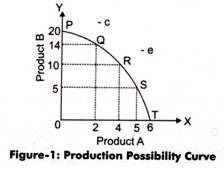As we know in the present day scenario, wants and desires of human beings have become unlimited and resources to fulfill those desires are limited.
Therefore, entrepreneurs need to select the most desirable goods that can be produced with available resources and technology.
On the other hand, if the resources had been available in unlimited quantities, then some of the sources would have left unutilized.
An economy has fixed population, resources, techniques of production, and raw materials. Therefore, it is necessary to decide upon the optimum utilization of resources to produce various goods. Production possibility curve provides an overview of the maximum output of a good that can be produced in an economy by using available resources with respect to quantities of other goods produced.
ADVERTISEMENTS:
In other words, production possibility curve can be defined as a graph that represents different combinations of quantities of two goods that can be produced by an economy under the condition of limited available resources. It is also known as production possibility frontier or transformation curve.
The goods and resources plotted on the production possibilities curve are considered as technically efficient, while the goods and resources that are lying beneath the curve are regarded as inefficient. The goods and services that lie beyond the curve are beyond the scope of economy. In the production possibility curve, only two goods are taken into account as a large number of goods cannot be represented on a two-dimensional graph.
Let us understand the concept of production possibility curve with the help of an example.
Suppose an organization produces two goods A and B.
ADVERTISEMENTS:
Table-1 shows different combinations of A and B produced by an organization:
In Table-1, it can be seen that when A has the quantity of 6000, then B has not been producer at all. Similarly, when the quantity of B reached 20 000 then the quantity of A is zero. This is because all the resources are utilized in manufacturing one good. However, these are the extreme cases. In between these cases, there are several points where A and B both are manufactured simultaneously.
Now, we can plot this table on a graph to obtain production possibility curve, which is shown in Figure-1:
In Figure-1, the production possibility point’s g and h are attainable combinations, whereas c and e are unattainable combinations. Production possibility schedule can also be termed as production transformation schedule.
The rate at which a product is transformed into another product by sacrificing the amount of one product for the other is called marginal rate of transformation. For example, in case of A and B, the amount of B that is sacrificed to produce A is termed a marginal rate of transformation. Due to this transformation, the curve of production possibility is concave in nature.
Production possibility curve not only provides solutions for production problems, such as what to produce and how to produce, but can be used for various purposes.
Some of its uses are as follows:
i. Enables the planning authority of a developed nation to divert the usage of its resources for the production of necessary goods to the production of luxury goods and from consumer goods to producer’s goods, after a certain point of time.
ii. Helps a democratic nation to focus and shift a major amount of resources in the production of public sector goods instead of private sector goods. The public sector goods are supplied and financed by government, such as public utilities, free education, and medical facilities. These goods are free or involve a negligible cost. On the other hand, private sector goods are manufactured by privately owned organizations and are purchased by individuals at a certain price.
iii. Helps in guiding the movement of resources from producer goods to capital goods, such as machines, which, in turn, increases the productive resources of a country for achieving a high production level.

